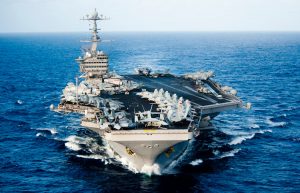A US aircraft carrier strike group, led by the USS John C. Stennis, is scheduled to arrive in the waters of the Persian Gulf by the end of the week, like reported by kurdistan24.net.
The aircraft carrier had been exercising in the Philippine Sea, off the coast of China. When it arrives off the Iranian coast, that will end an eight month period in which no US carrier group has been stationed in the area.
That is the longest period in 20 years—since the Clinton administration bombed Iraq for blocking UN weapons inspections—in which the US has had no such force in the area.
The Pentagon has sought to reorient US military assets toward Russia and China and away from the Middle East, but the “emphasis at times has appeared out of step with the White House which repeatedly has called Iran a top national security threat,” the Journal noted.
The movement of the carrier group comes amid rising tensions with Iran. Last month, the US imposed tough new sanctions on Tehran’s energy, financial, and shipping sectors, and Tehran, for its part, has warned of retaliatory action.
On Tuesday, Iranian President Hassan Rouhani threatened to halt all oil exports through the Strait of Hormuz.
The US “should know that we are selling our oil and will continue to sell it,” Rouhani asserted, but if the US “wishes to halt Iran’s oil export, then no oil will be exported from the Persian Gulf.”
“The great Iranian nation has not bowed and will not bow to the United States,” he affirmed.
Later the same day, Brian Hook, US Special Representative for Iran, responded, to Rouhani’s threat, telling journalists, “The strait is an international waterway. The United States will continue to work with our partners to ensure freedom of navigation and the free flow of commerce in international waterways.” (Hook earlier criticized Tehran for transferring missiles to militias in Iraq.)
On Saturday, shortly before heading to a NATO meeting in Brussels, Secretary of State Mike Pompeo issued a statement denouncing a recent Iranian missile test.
Tehran “has just test-fired a medium-range ballistic missile,” capable of carrying multiple warheads, Pompeo stated. “The missile has a range that allows it to strike parts of Europe and anywhere in the Middle East.”
“This test violates UN Security Council Resolution 2231 that bans Iran from undertaking ‘any activity related to ballistic missiles designed to be capable of delivering nuclear weapons,’” he continued.
Speaking on Wednesday in Brussels, Pompeo added, “Tehran holds multiple American hostages” and has “lied to the International Atomic Energy Agency inspectors about its nuclear program.”
He also noted that Iranian banks had been recently disconnected from the payment network known as SWIFT (Society for Worldwide Interbank Financial Telecommunications), which handles most international money transfers.
Meanwhile, the competition for influence in Iraq between Washington and Tehran continues. On Thursday, Iraqi media published photos of Qasim Soleimani, head of the Quds Force of Iran’s Islamic Revolutionary Guard Corps, meeting with a Sunni religious leader in Baghdad. Iraqi activists provided the pictures and said they were taken on Tuesday.
Eight cabinet-level positions remain unfilled in Iraq’s new government, including the Ministers of Interior and Defense. Parliament failed on Tuesday to approve Prime Minister Adil Abdul-Mahdi’s candidates, as the session degenerated into shouting and even fistfights.
A major source of dispute is the pro-Iranian orientation of the nominee for Interior Minister, and the unwillingness of some parties to accept him, including Sairoon, the largest electoral bloc, led by the Iraqi cleric, Muqtada al-Sadr.



